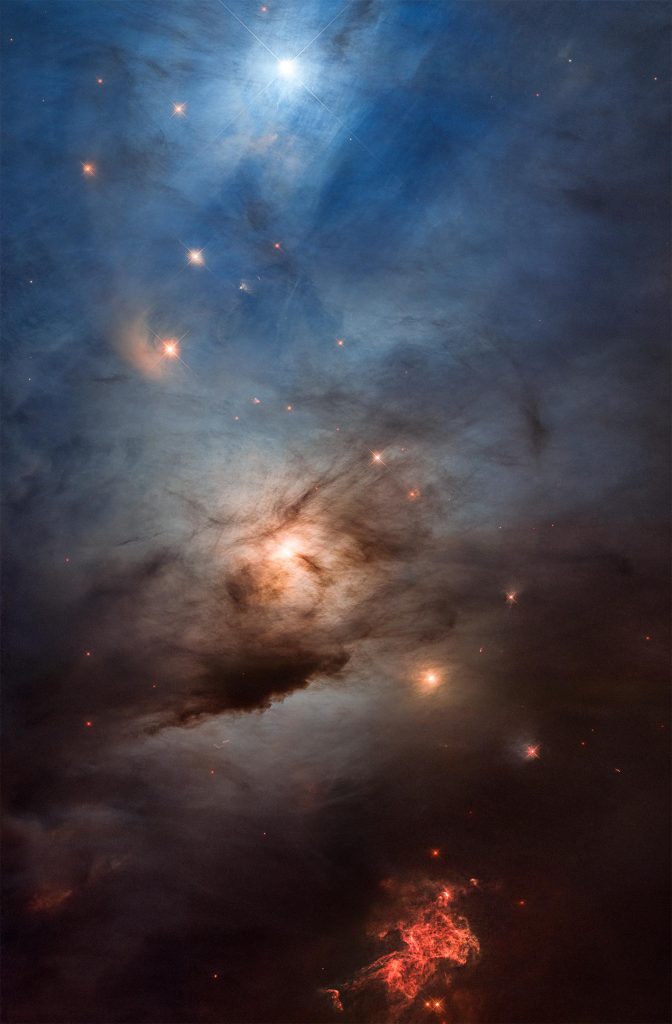
Hubble’s 33rd anniversary image unveils the mesmerizing chaos of star birth within the dark nebula NGC 1333, offering a glimpse into the early days of our own solar system. Credit: NASA, ESA, and STScI; Image Processing: Varun Bajaj (STScI), Joseph DePasquale (STScI), Jennifer Mack (STScI)
Dark Nebula is a Cauldron of Star Birth
You should know where you come from, but understanding the birth of our Sun and family of planets is largely sketchy because it happened 4.6 billion years ago. Trying to imagine far back in time, what were the initial conditions for the genesis of our solar system? Early astronomers thought the Sun formed in isolation, condensing from a wandering cloud of interstellar gas. This new picture of the nebula NGC 1333 offers a peek into the chaotic and messy star-formation process. For starters it shows that stars are not born in isolation but in batches. They are built from cold interstellar hydrogen that is laced with soot-like dust. Veils of dust block much of the Hubble Space Telescope’s view into the stellar cauldron. But young bright stars do poke out, like seeing sunlight pierce through clouds on a largely overcast day. Peering deep down inside, Hubble catches a glimpse of a fiery mosh pit of stars putting on their own fireworks show by blasting out jets of hot gas that look like July 4th Roman candles.
This photo was taken in celebration of the 33rd anniversary of the launch of the Hubble Space Telescope on April 24, 1990.
NASA is celebrating the Hubble Space Telescope’s 33rd birthday with an ethereal image of a nearby star-forming region, NGC 1333. Located approximately 960 light-years away in the Perseus interstellar cloud, Hubble’s colorful view unveils glowing gasses and pitch-black dust stirred up, colliding, and blown around by several hundred forming stars within the dark cloud. Credit: NASA’s Goddard Space Flight Center; Lead Producer: Paul Morris; Narration: Dr. Jennifer Wiseman
Hubble Space Telescope Celebrates 33rd Anniversary with a Peek into Nearby Star-Forming Region
Astronomers are celebrating NASA’s Hubble Space Telescope’s 33rd launch anniversary with an ethereal photo of a nearby star-forming region, NGC 1333. The nebula is in the Perseus molecular cloud, and located approximately 960 light-years away.
Hubble’s colorful view, showcased through its unique capability to obtain images from ultraviolet to near-infrared light, unveils an effervescent cauldron of glowing gasses and pitch-black dust stirred up and blown around by several hundred newly forming stars embedded within the dark cloud. Hubble just scratches the surface because most of the star-birthing firestorm is hidden behind clouds of fine dust – essentially soot – that are thicker toward the bottom of the image. The blackness in the image is not empty space, but filled with obscuring dust.
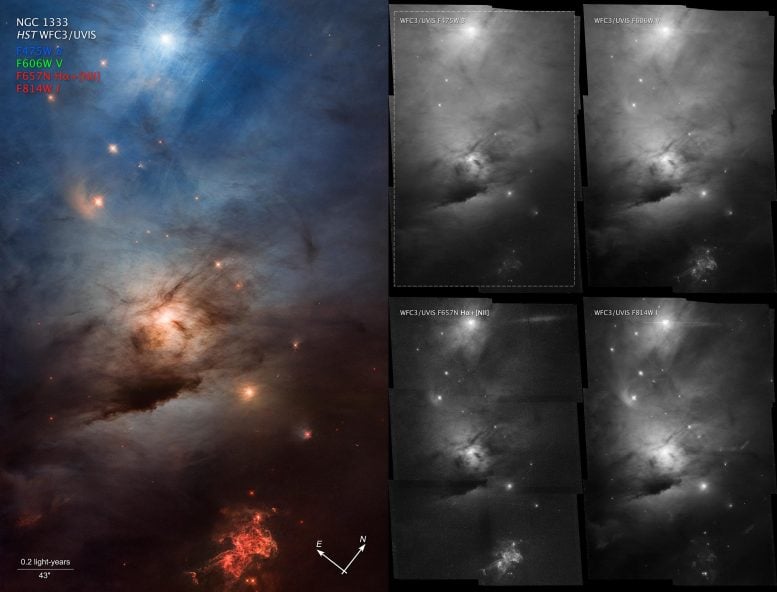
This is a compass graphic for the star-forming region NGC 1333. The left half is a color image of NGC 1333 labeled “NGC 1333, HST WFC3/UVIS”. Four filter labels are in blue (F475W), green (F606W), and red (F657N H-alpha plus NII, and F814W). At bottom a scale bar is labeled 0.2 light-years and 43 arcseconds. The right half shows four black-and-white panels in a two-by-two layout. Each panel is a view of NGC 1333 in an individual filter. At top left is F475W; at top right is F606W; at bottom left is F657N; at bottom right is F814W. Credit: NASA, ESA, and STScI; Image Processing: Varun Bajaj (STScI), Joseph DePasquale (STScI), Jennifer Mack (STScI)
To capture this image, Hubble peered through a veil of dust on the edge of a giant cloud of cold molecular hydrogen – the raw material for fabricating new stars and planets under the relentless pull of gravity. The image underscores the fact that star formation is a messy process in our rambunctious universe.
Ferocious stellar winds, likely from the bright blue star at the top of the image, are blowing through a curtain of dust. The fine dust scatters the starlight at blue wavelengths.
This is a video tour of the nebula NGC 1333 which lies on the edge of a gigantic dark cloud of cold molecular hydrogen laced with soot-like dust. This raw material fuels a firestorm of star birth taking place inside the dusty cocoon. Parts of it have broken through the veil of dust for the Hubble Space Telescope to see nascent stars that are creating a fireworks show. Credit: NASA, ESA, STScI
Farther down, another bright, super-hot star shines through filaments of obscuring dust, looking like the Sun shining through scattered clouds. A diagonal string of fainter accompanying stars looks reddish because dust is filtering starlight, allowing more of the red light to get through.
The bottom of the picture presents a keyhole peek deep into the dark nebula. Hubble captures the reddish glow of ionized hydrogen. It looks like a fireworks finale, with several overlapping events. This is caused by pencil-thin jets shooting out from newly forming stars outside the frame of view. These stars are surrounded by circumstellar disks, which may eventually produce planetary systems, and powerful magnetic fields that direct two parallel beams of hot gas deep into space, like a double lightsaber from science fiction films. They sculpt patterns on the hydrogen cocoon, like laser-light-show tracings. The jets are a star’s birth announcement.
This is a video zoom into the northern constellation Perseus, crossing 960 light-years of space. We come upon the nebula NGC 1333 that lies on the edge of a gigantic dark cloud of cold molecular hydrogen laced with soot-like dust. This raw material fuels a firestorm of star birth that is taking place inside a dusty cocoon. Parts of it have broken through the veil of dust for the Hubble Space Telescope to see nascent stars creating a fireworks show. Credit: NASA, ESA, STScI, Alyssa Pagan (STScI), Joseph DePasquale (STScI), Acknowledgment: KPNO, DSS
This view offers an example of the time when our Sun and planets formed inside such a dusty molecular cloud, 4.6 billion years ago. Our Sun didn’t form in isolation but was instead embedded inside a mosh pit of frantic stellar birth, perhaps even more energetic and massive than NGC 1333.
Hubble was deployed into orbit around Earth on April 25, 1990, by NASA astronauts aboard the Space Shuttle Discovery. To date, the legendary telescope has taken approximately 1.6 million observations of nearly 52,000 celestial targets. This treasure trove of knowledge about the universe is stored for public access in the Mikulski Archive for Space Telescopes, at the Space Telescope Science Institute in Baltimore, Maryland.
The Hubble Space Telescope is a project of international cooperation between NASA and ESA. NASA’s Goddard Space Flight Center in Greenbelt, Maryland, manages the telescope. The Space Telescope Science Institute (STScI) in Baltimore, Maryland, conducts Hubble and Webb science operations. STScI is operated for NASA by the Association of Universities for Research in Astronomy, in Washington, D.C.

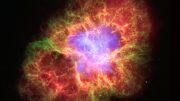
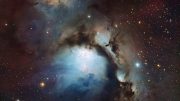

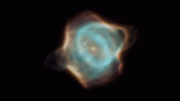
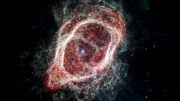
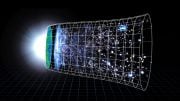
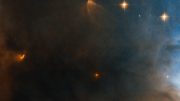
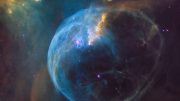
Be the first to comment on "Dark Nebula’s Stellar Cauldron Unveiled in Stunning Observation for Hubble’s 33rd Anniversary"